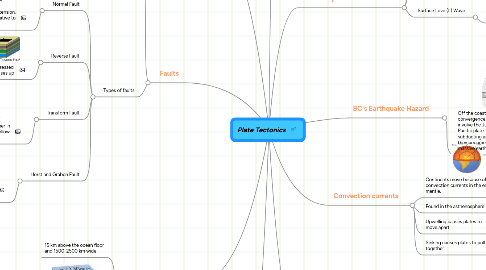
1. Layers of the earth
1.1. Mantle
1.2. Outer Core
1.3. Inner Core
1.4. Crust
2. Plate Boundaries
2.1. Diverging
2.1.1. Two plates are moving apart
2.1.2. Mid Atlantic ridge
2.1.3. Causes
2.1.3.1. Earthquakes
2.1.3.2. Volcanos
2.1.3.3. Rift valley is formed
2.2. Transform
2.2.1. Where plates are slipping and sliding past eachother
2.2.2. Causes
2.2.2.1. Volcanos
2.2.2.2. Earthquakes
2.3. Collision
2.3.1. Two plates are colliding together
2.3.2. Causes
2.3.2.1. Fold mountains
2.3.2.2. Earthquakes
2.4. Subducting
2.4.1. When 2 plates move towards eachother and meet, the heavier oceanic crust sinks below the contiental crust forming a trench
2.4.2. Causes
2.4.2.1. Earthquakes
2.4.2.2. Volcanos
2.4.2.3. Trench
2.4.2.4. Island Arc
2.4.2.4.1. An island arc is a chain of volcanoes which alignment is arc-shaped, and are parallel and close to a boundary between two converging tectonic plates.
3. Faults
3.1. What is a fault
3.1.1. A fault is in the earths surface where moemnt has occurred, and can be meteres to km's long
3.2. Types of faults
3.2.1. Normal Fault
3.2.1.1. When rock is stretched apart or in tension. One side of the fault slips down relative to the other
3.2.2. Reverse Fault
3.2.2.1. When rock is compressed together one side rises up
3.2.3. Transform Fault
3.2.3.1. When two plates slide past each other in different directions. Wich create shallow earthquakes
3.2.4. Horst and Graben Fault
3.2.4.1. Steep sided valley formed when faulting causes a blocked shaped area to drop
3.2.4.1.1. Horst : Land that moves upwards
3.2.4.1.2. Graben : Land that moves downwards
4. Mid-Ocean Ridges
4.1. 15 km above the ocean floor and 1500-2500 km wide
4.2. Sea-floor spreading
4.2.1. Is a process that occurs at Mid-Ocean Ridges, where new oceanic crust is formed through volcanic activity and then gradually moves away from the ridge
5. Earthquake waves
5.1. Primary (P) Wave
5.1.1. Consists of construction and expansion ( pushing/pulling ) wich causes back and fourth motion
5.1.2. Can travel through solids and liquids
5.2. Secondary (S) Wave
5.2.1. Move slowly, moves rocks up and down or side to side
5.2.2. Cannot travel through liquid
5.3. Surface Love (L) Wave
5.3.1. Most distructive wave because its surface moves like waves
6. Plate Movement
6.1. Plate movement causes
6.1.1. Folding
6.1.1.1. Process that bends and twists rocks due to compression or squeezing
6.1.2. Faulting
6.1.2.1. Process where rocks move past each other along a fracture pr crack, occurs where plates are seperating, sliding past, or comming together
6.1.3. Vulcanism
6.1.3.1. The movement of molten rock or magma, beneath or above earths surface
7. Earthquakes
7.1. Causes
7.1.1. Volcano
7.1.2. Landslides
7.1.3. Mining.Blasting
7.1.4. Nuclear Testing
7.2. Likely to occur at plate boundaries
7.3. Measuring Quakes
7.3.1. Moment magnitude scale
7.3.1.1. Measures the amount of energy released in a earthquake
7.3.2. Mercalli Scale
7.3.2.1. Used for measuring an earthquakes intensity. Measures impat on earths surface, humans, natural and man made structures. On a scale from 1-12
7.4. Epicentre
7.4.1. Is the point on the earths surface that is directly above the focus, the point where a earthquake originates
8. Convection currents
8.1. Continents move because of convection currents in the earths mantle.
8.2. Found in the asthenosphere
8.3. Upwelling causes plates to move apart
8.3.1. = Divergent plate boundary
8.4. Sinking causes plates to pull together
8.4.1. = Convergent plate boundary
